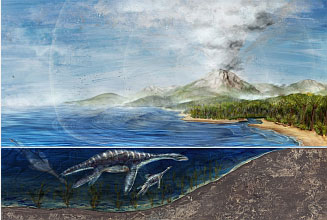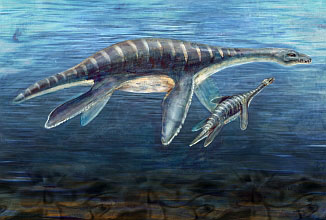‘Loch Ness Monster’ found in Antarctica
‘Loch Ness Monster’ found in Antarctica
mongabay.com
December 11, 2006
Paleontologists found a well-preserved fossil skeleton of a juvenile plesiosaur in Antarctica. Cryptozoologists say the plesiosaur resembles the legendary Loch Ness Monster, despite scientific evidence indicating that the marine reptile has been extinct for millions of years.
According to the international team of researchers who made the discovery, the find may be the best preserved remains of the species that roamed the waters of the Southern Ocean some 70 million years ago.
“The animal’s stomach area was spectacularly preserved… [and] the skeleton is nearly perfectly articulated as it would have been in life,” stated a release from National Science Foundation (NSF), which along with the Instituto Antártico Argentino, funded the 2005 expedition that discovered the plesiosaur. The expedition was lead by James E. Martin, curator of vertebrate paleontology and coordinator of the paleontology program at the South Dakota School of Mines and Technology’s Museum of Geology; Judd Case, of Eastern Washington University; and Marcelo Reguero of the Museo de La Plata, Argentina.
  A mother and juvenile plesiosaur could have looked like this artist’s rendering. The researchers say that temperatures in Antarctica were much warmer 70 million years ago. Credit: Nicolle Rager, National Science Foundation |
The remains were found at an elevation of 650 feet (200 meters) on Vega Island off the Antarctic Peninsula where harsh winds and freezing temperatures made excavation particularly difficult.
“Weeks of winds exceeding 70 miles an hour hindered the excavation,” explained an NSF statement. “At the end of the work, icy temperatures turned water to slush before plaster could be mixed to encase the fossil for transportation. The ground was so frozen a digging tool snapped in half during the excavation. Finally, a jackhammer had to be carried up to the site in backpacks along with gasoline, plaster, and water.”
“The resulting package of plesiosaur remains encased in a protective plaster jacket was too large to carry, so the Argentine air force brought helicopters to the rescue,” continued the statement. “It took five men to lift the specimen into the chopper, which delivered the cargo to the tent camp on the shores of Herbert Sound. The specimen was later picked up by the Laurence M. Gould, an NSF-chartered research vessel.”
The discovery of “volcanic ash beds layered within the shallow marine sands at the site” lead the researchers to speculate that volcanism may have caused the beast’s demise. Ironically the ask that likely killed the young plesiosaur may have also helped preserved the skeleton said the researchers.
This article is based on a news release from NSF.